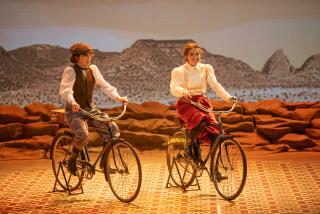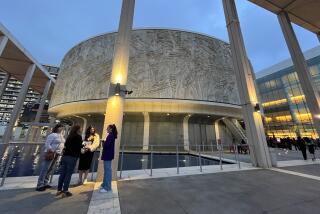As Center Theatre Group turns 50, an artistic director plots the second act (Hint: Think Hollywood)

A beat-up 10-speed bicycle leans against the wall in Michael Ritchie’s office on the second floor of the Center Theatre Group’s annex building in downtown L.A. Befitting a theater company artistic director, the decor summons East Coast professor more than Tinseltown mogul: yellow painted walls, mismatched furniture, crammed bookcases with neat stacks of scripts at their feet.
Asked if he rides the bike much, Ritchie reaches out and squeezes its soft front tire ruefully. It has been a while. “I have a bike at my house that I ride. This is my downtown bike. I do ride it sometimes. I’ll take it down the hill to lunch, or shoot up into Echo Park. But it’s more of a prop,” he says with a laugh.
Ritchie does know his props. He worked for years as a stage manager on and off Broadway. But as Center Theatre Group marks its 50th anniversary this month, the bike serves as an apt emblem of the challenges he has faced since he took over CTG from its founder, the revered Gordon Davidson, who retired in 2005 after running the company for 38 years.
Ritchie had been the artistic director of the Williamstown Theatre Festival in the Berkshires for 10 years, so he knew how to put together a season. But at CTG he’d have to program seasons for three venues, in different parts of a notoriously decentralized city: the 1,600-plus-seat Ahmanson Theatre and the 736-seat Mark Taper Forum at the Music Center in downtown L.A., and the 317-seat Kirk Douglas Theatre in Culver City. Each venue had its own mission, character, strengths and challenges, its own audience with specific expectations molded by Davidson’s vision — not to mention plenty of observers who believed the company should be doing something else entirely. More plays from New York. More shows developed in Los Angeles. More adventurous, avant-garde work. More crowd-pleasers.
Like everything in Los Angeles, CTG required commuting, and commuting meant not just spending time on the road but thinking about how to bridge distances, how to make the megalopolis feel like a neighborhood.
“When I first moved here, I really missed New York,” Ritchie says. Initially that included his family — his wife, the actress Kate Burton, and their two children, Morgan and Charlotte, now 28 and 18, who continued to live in New York while Morgan finished high school. “As the years passed, my affections have shifted, but there is one part of New York that I still miss, and it’s the small town. In the theater community, we live in the same neighborhoods, we go to the same restaurants. Here we’re so spread out.”
Ritchie says he has come to admire L.A. as “something completely different from New York. L.A. should never try to be New York.” At the same time, he continues to hope that CTG’s theaters can be hubs of connection.
His greatest desire for the future? “I could walk into the Taper, and walk down to the front of the stage and look up at the audience, and I would see Los Angeles sitting in that theater: every ZIP Code, every demographic. I would like to see a day when all of our theaters have that, regardless of the show that we’re programming.”
Fiftieth anniversaries are milestones that provoke soul-searching. “The 50th gives you two opportunities,” Ritchie says. “One of them is to remember the past, which you need to do. You need to look at the path you walked to get here.”
And the second?
“I think the more important thing is to imagine the future.”
In a gravelly voice that retains the accent of his native Massachusetts, Ritchie likes to say of decisions past: “That egg is boiled. I can’t make an omelet with it now.”
It’s more fun to talk about the future when exciting prospects are on the horizon, including his campaign to connect the world of L.A. theater to the world of film and television.
In eras past, it was a struggle to tempt Hollywood actors, writers and directors to the stage, he says They tended to bolt midrun at the slightest hint of a pilot.
But in the last few years, Ritchie says, all three industries have undergone disruption. New synergies have developed.
“There has been a much greater devotion to and appreciation for writing on television,” he says. “The television community has turned to theater writers to provide that. And so we’ve seen a geographical shift of playwrights from New York toward L.A., many of whom are writing on or executive producing on series but still want to be playwrights. Here in this building we noticed it happening. And we began reaching out to people in the greater entertainment industry.”
Robert Greenblatt, chairman of NBC Entertainment, who recently joined CTG’s board, is a perfect example, Ritchie says. “He fell in love with the theater in high school. In his heart he’s a theater man as well as a television man. He put ‘Hairspray Live!’ on television, successfully. … He’s good for us, both in terms of what he brings to our table, but also the signal he sends to everybody else out there in the business that theater is important. We in this town, an industry town, need to support theater, because a lot of our future is beginning in those walls.”
Ritchie has also been strengthening CTG’s relationships with smaller theaters. This month marks the Kirk Douglas’ inaugural Block Party, intended to be an annual showcase for local 99-seat houses. CTG has collaborated with smaller theaters in the past, including producing in 2002 Deaf West’s “Big River,” which went on to Broadway. But Block Party represents an ongoing commitment to fostering smaller, often cash-strapped but artistically adventurous companies.
Ritchie credits Lindsay Allbaugh, one of his associate producers, who worked in a 99-seat theater before joining CTG. But the showcase is part of his commitment — not always easy to perceive through frequent dust storms of criticism — to building up Los Angeles theater on multiple levels.
From the start Ritchie knew that filling Davidson’s shoes wouldn’t be easy. Davidson believed fervently in the nonprofit theater as a medium of social change. He opened the Mark Taper Forum in 1967 with “The Devils,” John Whiting’s play about a priest and a nun in 17th century France that was so lurid that an estimated one-third of its opening-night audience — including then-Gov. Ronald Reagan and wife Nancy — walked out. Undeterred, Davidson continued developing provocative plays with a social mission: “Zoot Suit,” which went on to become the first Latino play on Broadway, as well as “The Kentucky Cycle” and “Angels in America,” which both won Tony Awards.
Until his death last October, Davidson advised and supported Ritchie, who laughs off the suggestion that taking over as artistic director required courage. “Nobody was going to shoot me,” he says
He did come under fire quickly, however, when he discontinued the Taper Labs for Asian, Latino, black and disabled playwrights, arguing that they hadn’t generated many productions and that he and his staff could find other ways to increase diversity. “Will theater in Los Angeles fade to white?” asked Margo Jefferson in the New York Times. L.A. Times Theater Critic Charles McNulty, who came to Los Angeles around the same time as Ritchie, wrote in 2006, “Doubts about the place of diversity in his programming … have hung over his inaugural season like never-ending June-gloom cloud cover.” In the years since, McNulty has frequently criticized CTG for importing touring blockbusters at the expense of ambitious new work.
But as time passed, Ritchie began to win Los Angeles over. Although McNulty has been critical of the commercial direction of the nonprofit theater, he’s been encouraged lately by Ritchie’s willingness to show more diverse works and to take risks in programming even at the largest house, the Ahmanson, which recently had Belgian auteur Ivo van Hove’s production of “A View From the Bridge” as well as the lesbian coming-of-age musical “Fun Home.”
In Ritchie’s office is a large framed photograph of Samuel Beckett, whom he resembles in some indefinable but startling way. Maybe it’s their hair — steel gray streaked with white, brushed up and back from the crown — or their bright blue eyes, or their aristocratic noses. At 59, Ritchie lacks Beckett’s craggy, deeply lined complexion, but the kinship with the playwright is clear. “Oh, God, do I love Beckett,” he says with a grin. “Something about that dark, Irish, long, slow march toward death is like putting on a warm sweater on Christmas morning. It just makes my heart sing.”
But Ritchie is equally fond of light musicals, like “The Drowsy Chaperone,” which he brought to the Ahmanson during his first season, before it went on to Broadway and to the Tonys, where it won five awards.
And he also enjoys discovering and fostering new voices. “I’ve got a playwright downstairs right now, Rajiv Joseph. Ten years ago his play ‘Bengal Tiger at the Baghdad Zoo’ landed on my desk, and when I opened it up, there was a tiger in a cage, in Baghdad, talking directly to the audience. I remember thinking, ‘I don’t know if there’s a great play here, but the only way I’ll find out is if I produce it.’ It started at the Douglas, went to the Taper, went to Broadway. Rajiv is downstairs right now in rehearsal for another play [“Archduke”]. I don’t know that he’d be sitting downstairs or anywhere with that play if ‘Bengal Tiger’ hadn’t happened at the Douglas.”
Ritchie says he believes in the power of theater not only to effect social change but also to simply entertain. “For a lot of people, the two hours they have in the theater at night isn’t to remind them of what their daily life is like,” he says. “It’s to help them escape. And that has great value. I think every single show we do, from the ‘Zoot Suit’ that has major social importance and messaging, to ‘Drowsy Chaperone,’ which is the exact opposite, is delivering something incredibly important to somebody.”
Accomplishing that won’t be easy during changing times. The subscription-based business model that may have been brilliant in 1967 doesn’t work nearly as well in 2017, when theaters face so many competing forms of entertainment and audiences just aren’t eager to buy tickets a year in advance.
Ritchie has to ask himself the same questions theatrical producers have been asking throughout history: “How do you get people into the theater, how do you engage them, how do you bring them back, and how do you have the dependability to be able to plan, develop and program art, which is risky in and of itself, and yet still get a return on it?”
He may not have definitive answers, but he’s got time to find them. He doesn’t plan on going anywhere. “I will stay here as long as they will bear me,” he says. “I’ll tell you that flat-out. I’ve ended up where I’m going to finish. I’m home.”
SIGN UP for the free Essential Arts & Culture newsletter »
Follow The Times’ arts team @culturemonster.
ALSO
CTG at 50: The guy who knows all the Mark Taper Forum’s secrets
The duel is on: CTG to launch ‘Spamilton,’ the hit ‘Hamilton’ parody
More to Read
The biggest entertainment stories
Get our big stories about Hollywood, film, television, music, arts, culture and more right in your inbox as soon as they publish.
You may occasionally receive promotional content from the Los Angeles Times.






